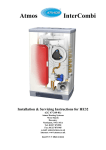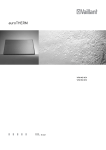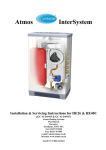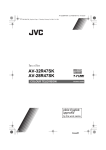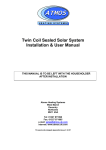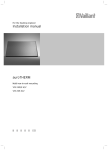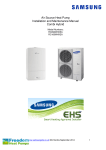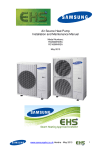Download Atmos Multi 32/80 Plus Installation manual
Transcript
ATMOS HEATING SYSTEMS MonoSolar and Solar Panels Installation Manual THIS MANUAL IS TO BE LEFT WITH THE HOUSEHOLDER AFTER INSTALLATION Atmos Heating Systems West March Daventry Northants NN11 4SA Tel: 01327 871990 Fax: 01327 871905 e-mail: [email protected] internet: www.atmos.uk.com Revised 11.5.05 MonoSolar & Solar Panels Installation Manual Page 2 of 29 Contents 1. 2. 3. 4. 5. 6. 7. 8. 9. 10. Introduction and Location 1.1 Introduction 1.2 Selecting the location of the Solar Panel and Tank Installing Roof-Integrated Solar Panels Installing Roof-Mounted Solar Panels Installing Solar Panels on Flat Roofs 4.1 Fixed Frame Method 4.2 Ballast Frame Method Installing the MonoSolar 5.1 Requirements 5.2 Assembly 5.3 Connecting the panel 5.4 Connecting the Domestic water circuit 5.5 Installing the Panel Sensor 5.6 Electrical Wiring/connections 5.7 Connecting the display to the wall 5.8 Power Supply 5.9 Filling the System 5.10 Commissioning Taking the MonoSolar out of service 6.1 Switching off 6.2 Draining the system – Draining the tank 6.3 Draining the system – Draining the heat exchanger Warranty Inspection, Maintenance and Faults 8.1 Inspection and Maintenance 8.2 Fault Diagnosis Technical Specifications 9.1 Technical Specification of Solar Panels 9.2 Technical Specification of MonoSolar Connections to Hot Water Systems 10.1 Connection to Atmos Compact Combi N30K Condensing Gas Boiler 10.2 Connection to Atmos Multi (24/80, 24/80 Plus, 32/80) Condensing Gas Boiler 10.3 Connection to Unvented Indirect HW System (Mains Pressure) 10.4 Connection to Vented Indirect HW System APPENDIX 1 MonoSolar Circuit Diagram APPENDIX 2 MonoSolar Commissioning Check List APPENDIX 3 Solar Panel Labelling MonoSolar & Solar Panels Installation Manual Page 3 of 29 4 4 5 6 8 8 8 10 11 11 11 15 15 16 16 16 17 17 17 18 18 18 18 18 19 19 20 21 21 22 23 23 24 25 26 27 28 29 1.0 1.1 Introduction and Location Introduction The Atmos MonoSolar makes use of advanced technology to produce hot water. It consists of a 100 litre insulated thermal storage tank, a heat exchanger, a multi speed pump, an electronic control module and a solar panel. Water from the storage tank is circulated around the solar panel, gaining heat from the sun. A 22mm copper heat exchanger coil immersed in the tank transfers the heat to the tap water, so that it can be used for low pressure or mains pressure applications. The circulation through the panel is called “low flow”. This means that the water flows slowly through the panel and therefore gets sufficient time to heat up. The water that returns from the panel into the cylinder has therefore the highest possible temperature. This water doesn’t mix with the colder water in the cylinder because it gently drops back. Because of this principle, the top of the water in the cylinder gets hot first, which means that hot water is available very quickly. This saves energy and cost. The MonoSolar has an in built control system which protects it against temperature extremes. If there is a risk of overheating in the summer, or of freezing in the winter, the circulation of water is automatically stopped, allowing water to flow back from the solar panel into the empty discharge space in the storage tank. This means the Atmos MonoSolar can operate without the addition of expensive antifreeze. The storage tank and solar panel form a sealed circuit so that there is no way oxygen can enter and form corrosion in the cylinder. Key Features • 100 litre heated water storage capacity. • Easy to install. • Compact dimensions. • High grade tank insulation to minimise heat loss. • Encased in rigid, cleanable pale grey plastic case. • Integrated drain back system. • Freezing and overheating safeguard. • No need for antifreeze. • Minimal maintenance. • Long life span. • Increases SAP rating of a house. Like all solar heating systems, an electric circulation pump is needed to pump the water round the system. This uses electrical energy, but the MonoSolar control system cleverly uses a multi-speed pump. On start up it runs for two minutes at high speed, and then the speed drops to low speed for the rest of the time. So whilst heat is being collected, the pump uses only 23 watts of electricity. This is a hidden but significant energy and cost saving feature. A thermostatic mixing valve ensures that the water flowing from the tank can be adjusted to meet user requirements, and avoid any possibility of scalding. MonoSolar & Solar Panels Installation Manual Page 4 of 29 The Controller The electronic control unit is neatly housed within the top of the tank, complete with a cover plate, which can only be removed with a screwdriver. It includes the sensor circuits for the tank and the solar panel. On the front face of the housing there is a light panel to tell the customer the temperature of the tank water and ‘Warming Up indication. When the sensors indicate that heat is available in the solar panel, the pump is switched on, and circulation begins, and ‘Warming Up’ indication is given. This continues until the solar panel temperature is within 2 degrees of the tank water temperature, when the pump will stop. It remains stopped until the sensors tell it that there is heat to be collected. If no hot water is used, the system will continue to collect heat energy until the tank reaches its maximum temperature. The pump will then remain static until such time as there is a temperature drop in the tank, which then starts the pump. 1.2 Selecting the location of the Solar Panel and the Tank 1.2.1 Select the most southerly facing and unshaded area of the roof for the solar panel. Be aware of the movement of shadows across the proposed location from chimneys, trees, etc and try to minimise this effect. Often the best position technically and visually, is in the centre of the roof. 1.2.2 The minimum angle of the roof, and therefore the solar panel, must be 30 degrees in order for the drain back to work effectively. The maximum height of the solar panel should be 20 metres (or between 20 and 70 metres with a limitation on geographical location). This ensures that the glass thickness meets regulations associated with resistance/ tolerance to wind. 1.2.3 Ensure that there will be enough space to fit the solar panel. Because of the flashing, in the case of roof-integrated panels, it is best to have at least one column of tiles between the panel and a vertical edge and at least 2 rows of tiles between the panel and the top of the roof. Ensure there will be sufficient access to the back of the panel from inside the roof space for connecting the water pipes and the sensor. 1.2.4 It is possible to install solar panels on vertical walls using a frame as used in Section 4.1, giving a sloping panel at 60 degrees to the horizontal. This will result in a small loss of performance, which can be more than compensated for by adding an additional panel. 1.2.5 To obtain the greatest efficiency, the pipe runs to the MonoSolar tank should be the shortest possible and also the tank should be as close to the boiler as possible. The pipes from the back of the solar panel to the tank must have a continuous fall and at no point must the fall be less than 40 mm per metre. The reason for the above is to ensure the removal of any water from the pipes when draining back, thus preventing any risk of freezing. 1.2.6 The MonoSolar tank must be installed in a frost-free room on a flat horizontal floor. There is a minimum draining level of the solar panel above the tank floor of 850 mm (alternatively 500 mm above the tank bracket for installations using a drain back header tank). There is a maximum vertical distance between the tank floor and the top of the solar panel (due to the pump) of 6.0 metres (alternatively 4.5 metres max above the tank bracket for installations using a drain back header tank). See also Figures 5.3 and 5.4. MonoSolar & Solar Panels Installation Manual Page 5 of 29 2.0 Installing Roof-Integrated Solar Panels 2.1 2.2 2.3 2.4 2.5 2.6 2.7 (For pantiles, etc, but not slates) Before commencing installation, please ensure that the flashing kit is correct for the size and type of panel configuration being used. For a single panel, it should contain the following items:1 x lead bib mounted on wooden lath, with solar panel clips. 2 x side flashings. 1 x top flashing. For a double panel configuration, it should contain an additional zinc joining channel as shown in Fig 2.4 Check that the sensor has been fitted to the panel before taking up to the roof. Mount the lath with the attached lead bib in the location, on the untiled roof, where the bottom of the solar panel is to be sited. This should be 140mm – 160mm above the first tile lath below the panel. Ensure that the lead flashing is square to the roof. Screw the lath to the roof trusses (Note – Use a minimum of 3 screws into the roof trusses) and seal the screw holes with lead flashing sealant. Fill any gaps between the tiles and the lath that might cause the lead flashing to sag with a wooden fillet. Insert the template (this is part of the solar panel packing) into the clamps on the lath, and use this to mark the position of the three holes required in the roof for the flow and return pipes, and the sensor pocket. Ensure that the marked positions do not intersect with any of the roof trusses. Cut the holes as marked, these should be a minimum of ∅80mm. Remove the screws in the panel glazing frame (Note – Use marking tape to help realign the cover later), allowing the cover to be removed. Hoist the panel base to the roof (Note – Care must be taken not to touch or damge the selective surface of the panel). Place the panel in position, with the bottom edge mounted in the clamps (see Fig.2.1), check that the holes in the roof are aligned with those in the panel. Using the 6 supplied screws, fix the panel to the roof laths. Install the side and top flashings (see Figures 2.2 & 2.3), ensuring that the top flashing sits on top of the side flashings. Use several stainless or galvanised roof sheeting screws down the side flashings into the battens, leaving them slightly proud, to hold the flashings in place. Hoist the solar panel cover to the roof. Firmly locate the flashings against the side of the panel by replacing the glazing cover. Re-secure the glazing frame with the screws. Ensure that the top flashing locates under the securing strip on the side flashing. Fold the lip to stop the side flashings sliding downwards. Tile around the panel, cutting tiles as necessary, dress the lead bib down on to the lower row of tiles. For some roof tiles, it might be necessary to fill the gap between the flashing kit and tiles with lead tiles. Finally check that the roof is completely watertight. MonoSolar & Solar Panels Installation Manual Page 6 of 29 Figure 2.1 Figure 2.2 Figure 2.3 Zinc Joining Channel Figure 2.4 MonoSolar & Solar Panels Installation Manual Page 7 of 29 3.0 Installing Roof-Mounted Solar Panels. (For slate tiles) A special surface mounting system is available for slate tiles. Contact Atmos for details. 4.0 Installing Solar Panels on Flat Roofs Solar panels may be installed on flat roofs using a separate A-frame. The frame may be secured to the roof by screws/bolts through the feet, or by ballasting. The securing plates for these two types are different, please ensure you have the correct frame for the chosen method. Check that the sensor has been fitted to the panel before taking up to the roof. [Note that an alternative solution is as follows: If the panels are mounted on a timber frame, with mounting face for the solar panel at 35 degrees to the horizontal, which is completely enclosed, this prevents any upward loading. Contact Atmos for more details.] 4.1 Fixed Frame Method 4.1.1 Assemble the relevant frame, as shown in Figure 4.1 below, using the supplied nuts, bolts and washers (additional assembly instructions may be found in the frame shipping box). 1 or 2 Module Long 1. Fixing foot 2. Upright 2 or 3 Module Standard 3. Bracing strut 4. Panel support Figure 4.1 4.1.2 Position the frame in the required area on the roof, drill through the holes in all four mounting feet, and fix to the roof using screws or anchor bolts depending on the roof material. Note – please refer to table 1, for maximum building heights and screw/bolt strengths. The roof may need to be opened to find a suitable supporting wall to withstand the potential uplift force of the solar panel in windy conditions. Please also note that the force is an uplift force and so the fixing may have to be located a considerable distance down into the wall. 4.1.3 The foot plates should be weather sealed by felting over the base plates, using a suitable membrane such as EPDM. 4.1.4 The two supplied silicone pipe flashings should be used to seal the flow and return roof penetrations. These flashings should be further sealed with EPDM membranes. 4.1.5 Once the frame has been fixed, locate the solar panel in position, using the coach bolts on the panel support strut to position the panel on the frame. Ensure the solar panel is level and then drill Ø 9mm holes through the top and bottom lips of the panel in line with the centre of the support struts. Secure the panel to the frame with the bolts supplied. MonoSolar & Solar Panels Installation Manual Page 8 of 29 Maximum building height and strength of the screws/bolts to be used to connect the base plate to the roof. Max. Building Tensile Strength of Fixing Solar Panel Type Area Height Front Plate Back Plate 1-Module TYPES B & C 2-Module Standard TYPE D 2-Module Long TYPE F 3-Module Standard TYPE G Wind area codes: Note I II III I II III I II III I II III 35m 35m 35m 12m 20m 35m 12m 20m 35m 3m 6m 12m 600N 600N 600N 600N 600N 600N 1000N 1000N 1000N 1000N 1000N 1000N 600N 600N 600N 600N 600N 600N 600N 600N 600N 1000N 1000N 1000N Area I – High wind areas (open countryside) Area II – Medium wind areas (wooded country, suburban areas) Area III – Slow wind areas (built-up areas) 1 module = 1.38m2, 2 module = 2.75 m2, 3 module = 4.12 m2 (TYPE A, B, etc – see Technical Spec) Table 1 MonoSolar & Solar Panels Installation Manual Page 9 of 29 4.2 Ballast frame Method 4.2.1 Assemble the relevant frame, as shown in Figure 4.2 below, using the supplied nuts, bolts and washers (additional assembly instructions may be found in the frame shipping box). 1 or 2 Module Long 1. Fixing foot 2. Ballasting frame 3. Bracing strut 2 or 3 Module Standard 4. Solar Panel support 5. Upright Figure 4.2 4.2.2 Position the frame in the required area on the roof, and ballast the frame with concrete slabs. The required weight of the slabs for each solar panel can be found in table 2, below. Wind area Sol. panel type Sol. panel weight Frame weight Max height (m) 3 6 9 12 15 20 25 30 35 Area I 1-mod 2-mod 3-mod 37 54 80 30 30 30 Ballast weight 172 395 241 532 282 614 316 682 340 *** 374 *** 402 *** 422 *** 443 *** (kg) 608 *** *** *** *** *** *** *** *** Area II 1-mod 2-mod 3-mod 37 54 80 30 30 30 Ballast weight 118 285 183 415 224 497 254 559 278 607 309 668 337 *** 387 *** 378 *** (kg) 444 639 *** *** *** *** *** *** *** Area III 1-mod 2-mod 3-mod 37 54 80 30 30 30 Ballast weight 90 231 135 320 172 395 200 419 220 450 251 552 275 600 296 641 313 675 (kg) 362 495 608 690 *** *** *** *** *** The ballast shown in the table must be distributed 2/3 to the back and 1/3 to the front of the frame These figures are a guide only, the ballast weight for a particular site should be calculated by a qualified engineer. See table 1 for wind area codes. Note 1 module = 1.38m2, 2 module = 2.75 m2, 3 module = 4.12 m2 Table 2 MonoSolar & Solar Panels Installation Manual Page 10 of 29 5.0 5.1 Installing the MonoSolar Requirements See also sections 1.2.5 & 1.2.6. If the distance between the bottom of the MonoSolar and the top of the panel is greater than 6.0 metres, then a drain back vessel must be fitted. See Fig 5.3 & 5.4. Alternatively a second pump can be fitted, increasing the max. distance to 11.0m. The following items are needed for the installation:• 8mm OD copper pipe (Solar panel flow) • 10mm OD copper pipe (Solar panel return) • 15mm OD copper pipe (cold water inlet and hot water outlet) • pipe insulation (see section 5.3) • sensor cable (see section 5.6) • drain cock type A and other items (see section 10) NOTE -Expansion The MonoSolar has space in the tank to allow for expansion and contraction and hence a separate expansion vessel is not needed. 5.2 Assembly 5.2.1 The parts supplied are shown in Figure 5.1 below. See also Figure 5.2. Note The sensor may be supplied with the solar panel. Figure 5.1 Insert outlet bend using PTFE tape. Wind four times around the thread of the bend. 5.2.3 Remove one of the side entry plugs (preferably the one nearest the panel) and fit the outlet bend to rest in the vertical plane. 5.2.4 Fit pump and pipe work. 5.2.5 Fit a drain cock type A on the other side. 5.2.6 Unscrew the two screws on the side of the lid and remove the lid. 5.2.7 Remove the red cover of the 15mm pipe to the top of the cylinder and connect the T-piece. Plug the connection using the plug removed from the side of the tank. 5.2.8 Connect the 3 bar pressure relief valve with PTFE tape to the riser pipe and fit a 22mm pipe to the outside via a tundish. PLEASE NOTE! It is possible that ‘dead water’ will come out of the system when you remove the plug. This water can cause stains on your carpet! 5.2.2 MonoSolar & Solar Panels Installation Manual Page 11 of 29 Figure 5.2 Note Dimensions are as follows:Height Width Depth 900 mm 640 mm including pump 500 mm MonoSolar & Solar Panels Installation Manual Page 12 of 29 Figure 5.3 Note Solar panel has RED label marked FROM COLLECTOR. (ie Panel Flow). Solar panel has BLUE label marked TO COLLECTOR. (ie Panel Return). All solar panel pipes must have a fall of 40mm/metre or better and be insulated. MonoSolar & Solar Panels Installation Manual Page 13 of 29 Figure 5.4 Note Solar panel has RED label marked FROM COLLECTOR. (ie Panel Flow). Solar panel has BLUE label marked TO COLLECTOR. (ie Panel Return). All solar panel pipes must have a fall of 40mm/metre or better and be insulated. MonoSolar & Solar Panels Installation Manual Page 14 of 29 5.3 Connecting the panel 5.3.1 5.3.2 5.3.3 5.3.4 5.3.5 5.4 Do not use plastic pipes. Connect the 10mm solar panel return pipe to the elbow. Connect the 8mm solar panel flow pipe to the T-piece, feeding this pipe through the black grommet of the connection plate. Use compression fittings. Make sure that all pipes are protected by the roof insulation, using fibreglass and tape the back of the panel with aluminium tape. Do not use PUP foam. Insulate the panel flow and return pipes with material with an inside diameter of 10mm which is able to resist temperatures up to 1750C (HT Armaflex – intermittent rating). Make sure that the pipes are well supported, using suitable clips. Connecting the Domestic water circuit (See also the diagrams in Section 10) NOTE As it is possible for the water from the MonoSolar to reach 850C, it is essential that a thermostatic mixing valve is included in the domestic water circuit. 5.4.1 Ensure your domestic water supply is mains pressure. Flush the pipes before connecting them. Connect the water supply to the cold water inlet of the MonoSolar system, using 15mm pipe fed through the blue grommet of the connection plate. 5.4.2 Connect the hot water outlet of the MonoSolar to the cold-water inlet of the boiler (or tank as shown in Section 10), using 15mm pipe fed through the red grommet of the connection plate. All Atmos Multi and Atmos Compact boilers are compatible. Seek your Supplier’s advice for other appliances. 5.4.3 Tighten all connections and fill up the system. Check all connections for leakage. Figure 5.5 MonoSolar & Solar Panels Installation Manual Page 15 of 29 5.5 Installing the Solar Panel Sensor 5.5.1 5.5.2 5.6 Electrical Wiring/connections 5.6.1 5.6.2 5.6.3 5.7 The panel sensor must be fixed in place into the left or right opening on the side of the panel by means of a clamping arrangement. Note that the sensor may be supplied with the panel and clamped in position. Check the screws for tightness. Seal the sensor opening with insulating material. The electrical wiring of the MonoSolar is complete and should not be altered or adjusted in any way. The circuit diagram is given in the Appendix. Connecting the panel-pump Make the electrical connections to the pump according to the circuit diagram. Connecting the panel sensor Connect the plug of the panel sensor to the connector block of the MonoSolar with a two-core cable. PLEASE NOTE: Make sure that the sensor wire doesn’t come in contact with the panel pipes. The high temperatures of the pipes can damage the insulation of the electrical wires! Connecting the display to the wall 5.7.1 5.7.2 5.7.3 5.7.4 5.7.5 If preferred the display can be disconnected and fitted remotely on a wall. For this you need a four-core cable and a four-way connector block (available from Atmos). Disconnect the display electrical connections from the control box. Unscrew the display and replace it with the cover. Screw the spare cover unto the casing. Remove the front of the display by lifting the sides with a screwdriver. Fit display on the wall and connect the four-core cable between the display and the control panel, observing current electrical regulations. Refit the lid. Figure 5.6 MonoSolar & Solar Panels Installation Manual Page 16 of 29 5.8 Power Supply The MonoSolar requires a 230 volts, 3 Amp, earthed electrical supply via either a standard plug, or switched fuse spur. 5.9 Filling the System 5.9.1 5.9.2 Remove the plug on the T-piece. Open the water level drain valve at the riser pipe. This level is the filling level (see Fig 5.5). 5.9.3 Connect the filling hose to the filling tap connection and open the tap. Fill the appliance with clean drinking water. You can hear the tank filling up. When the noise reduces, the tank is nearly full. At this point the filling tap can be partially closed. When the tank is sufficiently filled, water will run out of the drain valve. Close the filling tap and remove the hose. NOTE Do not overfill the tank, otherwise the expansion air gap would be reduced. 5.9.4 Close the drain valve and replace the plug on the T-piece. 5.9.5 Ensure all connections are watertight. 5.9.6 If a drain back vessel is fitted, then keep the hose on the filling tap when the MonoSolar is full. Close the drain valve and replace the plug on the T-piece. Open the valve tap on the bottom of the drain back vessel and patiently fill up the system from the filling tap on the MonoSolar. Close the filling tap when the water is no longer filling (ie. water starts to flow out of the vessel valve tap). Remove the hose and close the valve tap when the flow from the vessel valve tap has stopped. PLEASE NOTE! If the MonoSolar hasn’t got a filling tap, then a 8mm copper tube with a filling hose can be fitted temporarily to the filling connection. In this case, disconnect the thermostat tube temporarily to allow air to escape from the appliance. 5.10 Commissioning Warning: Do not connect the MonoSolar electrically until it has been charged with water! Remove plug in the end of the pump and ensure that pump shaft rotates freely. Replace plug. When you electrically power the MonoSolar, the pump will run continuously for 5 mins. The pump will run on full capacity for a couple of minutes to fill up the panel with water, then the standard pump speed will be selected. If there is sufficient daylight, the pump will continue running. When the solar panel temperature increases sufficiently, the pump speed will also increase. Please note: Check the installation and the solar panel circuit for leakage. Warning: Do not disconnect the electrical supply when the MonoSolar is operating. MonoSolar & Solar Panels Installation Manual Page 17 of 29 6.0 6.1 Taking the MonoSolar out of service Switching off The MonoSolar can be switched of by unplugging it, preferably in the morning or evening, when the pump is not running. 6.2 Draining the system – Draining the tank 6.2.1 6.2.2 6.2.3 6.3 Let the tank cool down by running the domestic hot water until all lamps on the display are off. Immediately disconnect the electrical supply. Drain with a hose connected to the drain cock at the base of the tank. Draining the system – Draining the heat exchanger 6.3.1 6.3.2 6.3.3 Close the tap to the cold water inlet. Disconnect the cold and hot water pipes from the MonoSolar. Connect a hose into the cold-water inlet of the appliance and siphon the water into a drain. PLEASE NOTE! After you have drained the appliance, there will be some water left in the heat exchanger. In case of removal for transport, open ends need to be sealed. 7.0 Warranty Warranty information is provided with the MonoSolar and solar panels. Warranty does not cover the following:• Costs of collection. • Transport costs. • Admin costs. • Transport damage. • Consequential damage (e.g. Company damage, water damage, fire damage). PLEASE NOTE The responsibility for giving compensation lies firstly with the installer / supplier where the appliance is acquired. MonoSolar & Solar Panels Installation Manual Page 18 of 29 8.0 8.1 Inspection, Maintenance and Faults Inspection and Maintenance The Atmos MonoSolar system is built from maintenance free components. However, it is advisable to inspect the following annually:Control Check the wiring and check if the pump starts running when there is sufficient daylight. (The hot water tap can be opened when the tank is too hot.) Pipes Check the pipes if they are well supported within the roof insulation and not bent. Also check the pipe insulation and other insulation. Filling level a) Disconnect the electrical supply and wait for about 5 minutes. Make sure that the solar system is cooled down. This is usually the case in the morning. Alternatively, open a hot water tap until all the temperature indication lights have gone off. Wait 5 minutes until the water has drained back to the tank. b) Remove the lid and open the plug on the T-piece. c) Open the water level drain valve on the riser pipe. d) If there is no water coming out of the side, fill up the tank to the correct level as described in section 5.9. e) Refit the cover. f) Restore electrical power and check the unit operates. g) Check for leaks. Filling level with a drain back vessel a) Disconnect the electrical supply and wait for about 5 minutes. Make sure that the solar system is cooled down. This is usually the case in the morning. Alternatively, open a hot water tap until all the temperature indication lights have gone off. Wait 5 minutes until the water has drained back to the tank. b) Open the valve tap on the drain back vessel. c) If no water comes out, fill up the vessel as described in Section 5.9. d) After filling, close the valve tap. e) Restore electrical power and check the unit operates. f) Check for leaks. MonoSolar & Solar Panels Installation Manual Page 19 of 29 8.2 Fault Diagnosis Condition 1. The display does not give any indication in sunny periods. 2. The MonoSolar does not start operating even though the sun shines and the display works. 3. You hear the sound of dripping water in the tank. 4. You can hear the pump running. 5. The panel ‘whistles’ whenever the pump is running. 6. The temperature on the display does not change while the MonoSolar has been operating for a number of hours. Diagnosis/ Comment a) Ensure healthiness of electrical supply b) Disconnect the electrical supply, remove the cover and check: • The 3.15A fuse (20x5mm) • The electrical connections to the power supply and/or display • The solar panel sensor and wiring The display indicates the tank temperature. The temperature of the panel is equal or lower than the temperature of the water in the tank. If this is not the case: a) Disconnect the appliance, remove the cover/lid and check: • The cable to the pump has not been connected. • The wiring of the pump is defective. b) The pump is defective and needs to be replaced. c) The appliance has just been connected and meanwhile the appliance reached a temperature over a 1000C. The appliance will cool down by short periods of circulation at intervals until it has reached the right temperature. a) In case the solar system has just started to operate, wait until the pump speed has come down and listen again. b) Check the filling level of the tank as described in ‘Inspection and Maintenance’ (section 8.1). c) Check if there is a leakage in the solar panel circuit. Whenever the temperature increases, the pump speed will increase. This is audible. Disconnect the electrical supply when the solar panel is cool and allow the panel to drain. Disconnect the flow pipe from the panel. Remove the washer from behind the reducer. Clean/clear the hole. a) The tank heat sensor is not operating. Disconnect the appliance, remove the cover/lid and check: • The connector from the sensor is not connected or is defective. • The display is defective. b) There is no circulation through the solar panel: • The pipes to and from the panel are too long. • The height of the top of the panel is greater than the maximum allowed (see Fig 5.3 & 5.4). • The panel flow and return pipe are not in copper 8mm and 10mm OD pipes respectively. d) The solar panel is frozen up: • The flow and/or return pipes are not insulated properly. • The solar panel is not level on the roof. MonoSolar & Solar Panels Installation Manual Page 20 of 29 9.0 9.1 Technical Specifications Technical Specification of Solar Panels TYPE ZEN MODELS: Measurements and weights: B A A D E F C G I J H K (or Collectors) MODEL HEIGHT mm A B C D E F G H I J K 910 1776 910 1776 3491 910 1776 2596 3433 4276 5119 X WIDTH mm WEIGHT kgs 910 910 1776 1751 910 3491 2596 1776 1776 1776 1776 18 31 31 55 60 60 84 84 117 146 175 APERTURE AREA – m2 0.69 1.38 1.38 2.75 2.76 2.76 4.12 4.12 5.50 6.88 8.26 All collectors 105mm deep ABSORBER PLATE: Copper sheet and tube bonded over the full length of the pipe in an automated soldering process Selectively coated surface layer: absorption coefficient = 0.96; emission coefficient = 0.08 Interchangeable by means of compression fittings, after removal of glass cover GLASS COVER: Low iron, toughened, low reflection glass, 3.2mm thick Removable with aluminium frame cover Light transmittance = 92% SOLAR PANEL BOX: Heavy aluminium box section with black anodised aluminium glass cover frame. A sensor pocket is located at the top back side of the solar panel INSULATION: All insulation materials are 100% CFC-free FLOW AND RETURN: 15mm compression fittings FLUID CONTENT: 0.5 litre per square metre of panel area RECOMMENDED FLOW RATE: 0.5 litre per minute per square metre of panel area TEST PRESSURE: 6 Bar PRESSURE DROP: 4.94 kPa per solar panel at flow rate of 0.03 litres per second FIXING METHODS: (1) Roof integrated using flashing kit; (2) Flat roof mounted with Aframes and ballast or roof fixings EFFICIENCY: η = 0.7847 – 3.4746 T* - 0.01572 G T*2 TESTED BY: TNO The Netherlands, TüV Munich, ISFH Institute Germany, Switzerland and Denmark LIFE EXPECTANCY: 25 to 30 years APPLICATIONS: small to large domestic hot water systems, industrial process and swimming pool heating MonoSolar & Solar Panels Installation Manual Page 21 of 29 9.2 Technical Specification of MonoSolar Contents of heated water 100 litre Solar Panel liquid Domestic drinking water Material Container Steel Insulation material of cylinder Foam (CFC Free) Max pressure container/cylinder 3 bar Max head of pump 6.5m Type heat exchanger Spiral coil Contents of heat exchanger 5 litre Material of heat exchanger Copper Panel surface 2.75m2 / 4.12m2 Annual energy generated by 2.75m2 panel according to DST (TNO Report No 99-BBI-R031) 3.4GJ (944kwH) Annual energy generated by 4.12m2 panel according to DST (TNO Report No 99-BBI-R114) 3.9GJ (1083kwH) Solar Panel - Absorber material and coating Solar Panel - cover Black chrome on copper (absorption coefficient = 0.96) (emission coefficient = 0.12) Iron free reinforced glass Solar Panel - casing Unpainted or black aluminium Design flow 25 litres/hr per square metre of collector area ie 69 litres/hr for 2.75m2 103 litres/hr for 4.12m2 MonoSolar & Solar Panels Installation Manual Page 22 of 29 10.0 10.1 Connections to Hot Water Systems Connection to Atmos Compact Combi N30K Condensing Gas Boiler ATMOS COMPACT N30K SOLAR COMPATIBLE CONDENSING GAS COMBINATION BOILER SOLAR PANEL ON ROOF 8mm FLOW from panel CH flow and return 15mm Cold inlet from MonoSolar TMV = 15mm thermostatic mixing valve TMV 15mm nonreturn valve HOT WATER OUT 15mm 10mm RETURN to panel 15mm 22mm COLD WATER IN MonoSolar safety discharge pipe 15mm PUMP MONOSOLAR THERMAL STORE Notes; 1) Hot outlet from MonoSolar connects directly to the cold inlet of the COMPACT boiler. Do not fit any stop tap in this line. 2) Cold feed to thermostatic mixer valve should be taken from the 22mm cold supply. 3) The 15mm copper safety valve discharge pipes from the boiler and from the MonoSolar can be linked into a common 22mm copper discharge pipe. MonoSolar & Solar Panels Installation Manual Page 23 of 29 10.2 Connection to Atmos Multi (24/80, 24/80Plus,32/80) Condensing Gas Boiler SOLAR PANEL ON ROOF ATMOS MULTI SOLAR COMPATIBLE CONDENSING GAS COMBINATION BOILER CH flow and return HOT WATER OUT 22mm TMV = 22mm thermostatic mixing valve 8mm FLOW from panel 10mm RETURN to panel TMV 22mm Cold inlet from MonoSolar 22mm COLD WATER IN UV3 kit including PRV , non-return valve and 6 bar safety relief MonoSolar safety discharge pipe 15mm PUMP Potable exp vessel MONOSOLAR THERMAL STORE Notes; 4) 5) 6) 7) The above is diagrammatic only, not to scale. See manufacturers installation instructions. UV3 kit must be fitted before the MonoSolar tank. All hot and cold water pipework in 22mm copper. Hot outlet from MonoSolar connects directly to the cold inlet of the Multi boiler. Do not fit any stop tap in this line. 8) Cold feed to thermostatic mixer valve should be taken from the 22mm cold outlet of the UV3 kit. 9) Potable expansion vessel connection should be taken from the 15mm connection of the TMV. 10) Safety valve discharge pipes from boiler and UV3 kit (15mm) should be linked together into 22 mm copper. The joint discharge pipe should be sized and fitted in accordance with Building Regulations G3. 11) The 15mm copper safety valve discharge pipes from the boiler (Robokit) and from the MonoSolar can also be linked into the above discharge pipe. However there must be a tundish or tundishes fitted so that any discharge can be traced to its source. MonoSolar & Solar Panels Installation Manual Page 24 of 29 10.3 Connection to Unvented Indirect HW System (Mains Pressure) SOLAR PANEL ON ROOF Cold water inlet Unvented fittings including pressure reducing valve and 6 bar pressure relief valve refitted before MonoSolar 8mm FLOW Stop tap Thermostatic mixing valve Unvented hot water tank 10mm RETURN Blended Hot water out PUMP MONOSOLAR THERMAL STORE The Atmos MonoSolar can be installed as a pre-heat tank to an unvented hot water tank. The unvented tank will be fitted with a pressure reducing valve and 6 bar safety relief valve (UV assembly) on the cold water inlet side. When installing the MonoSolar tank, ensure that this UV assembly is on the inlet side of the MonoSolar, and that there is no valve between the hot water outlet and the cold water inlet of the unvented hot water tank. The water in the MonoSolar can reach 85 oC in the summer, and the UV assembly is not be suitable for use with water at this temperature, which is why it must be situated on the cold water side. Furthermore a thermostatic mixer valve must be fitted on the hot water outlet to prevent scalding. MonoSolar & Solar Panels Installation Manual Page 25 of 29 10.4 Connection to Vented Indirect HW System SOLAR PANEL ON ROOF HEADER TANK 8mm FLOW Gate Valve 10mm RETURN Hot water out Existing hot water tank PUMP MONOSOLAR THERMAL STORE MonoSolar & Solar Panels Installation Manual Page 26 of 29 APPENDIX 1 MonoSolar Circuit Diagram MonoSolar & Solar Panels Installation Manual Page 27 of 29 APPENDIX 2 MonoSolar Commissioning Certificate (& Check List) Check List Tick/Comment 1. Solar panel is in good location and without significant shading. 2.Solar panel orientation is correct and flow pipe taken to RED label of panel. 3. Solar panel is securely mounted and flashing secure. 4. In the case of roof – integrated panels:Lead flashing at bottom of solar panel is securely fixed, supported, dressed down onto the lower tiles. The side flashings are located against the side of the panel by the glazing cover; the top flashing sits on top of the side flashings and located under the securing strip on the side flashing. The lip is folded to stop the side flashings sliding down. 5. External pipes are insulated with high temperature insulation (eg Armaflex). 6. Panel temperature sensor is clamped in place correctly. 7. Roof fixings robust and weather tight; roof penetrations made good. 8. MonoSolar and drain back (if fitted) are correctly positioned (min level of the bottom of the solar panel above the tank floor is 850mm/ alternatively 500mm min above the drain back tank bracket), (max vertical distance from the top of the solar panel above the tank floor is 6.0metres/ alternatively 4.5metres max above the drain tank bracket). 9. Panel flow pipe is taken from the top of the MonoSolar to the top of the panel (RED label) in 8mm copper, has a fall of at least 20mm per metre, and is insulated in high temp insulation and adequately clipped. 10. Panel return pipe is taken from the MonoSolar to the bottom of the panel (BLUE label) in 10mm copper, has a fall of at least 20mm per metre, and is insulated in high temp insulation and adequately clipped. 11. Panel sensor cable (silicon type) is not in contact with the panel pipes, and is kept separate from other wiring and adequately clipped. 12. All cables to the MonoSolar are taken into the top enclosure through the glands. Power cable has 230 volts, 3 amp, earthed electrical supply. 13. Equipotential bonding is refitted. 14. MonoSolar (or Drain back vessel, if fitted) filled to correct level and system checked for leaks. 15. The operation of the MonoSolar has been checked and LED’s operate correctly. The water flow is from pump to panel to MonoSolar tank (or via Drain back vessel, if fitted). The pump unit is fixed securely and not vibrating or noisy. 16. Maintenance of system explained to the Customer and the MonoSolar Installation Manual left with the Customer, together with a signed copy of this sheet. Customer’s Name Installer’s Name (IN CAPITALS) or firm Installer’s Signature Installer’s Phone No Date of Completion MonoSolar & Solar Panels Installation Manual Page 28 of 29 APPENDIX 3 Solar panel Labelling The following information needs to be kept near to the solar panels (preferably displayed) :Manufacturer: Zen Year of Production: Within 1 year of installation date Country of production: Holland or Begium Glazing format: flat plate Primary absorber insulation method: glass wool Maximum stagnation temperature at 1000W/m2 and 300 C ambient: 160 deg. C Maximum operating pressure: 3 Bar Fluid content: 1 litre/1 square metre of collector area Ref number Gross collector area: Weight, empty: 511-0033 1.38 m2 28 kgs MonoSolar & Solar Panels Installation Manual 511-0036 2.75 m2 55 kgs landscape 511-0048 4.12 m2 84 kgs Page 29 of 29 portrait 511-0050 4.12 m2 84 kgs





























